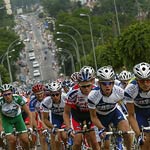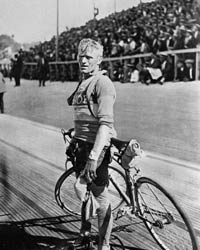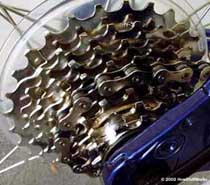| (insert your NIE or newspaper logo here) |
Weekly Online LessonOnline Lesson ArchiveGrade Level: 6-12
|
The Centenary Tour de France
 On
Sunday, July 20, 2003, Italian cyclist Gilberto Simoni won Stage 14
of the Tour de France, a tough 191-kilometer stretch in the Pyrenees
Mountains.
On
Sunday, July 20, 2003, Italian cyclist Gilberto Simoni won Stage 14
of the Tour de France, a tough 191-kilometer stretch in the Pyrenees
Mountains.
This year's Tour de France is the 90th of its kind in 100 years (some seasons were missed during the two World Wars). The 2003 race includes 20 stages of road racing that begins in Paris and returns there, after three weeks and 2,077 miles (3,350 kilometers) of riding through the French countryside.
The race pushes the skills and endurance of the athletes, as well as the efficiency and durability of their gear. The competition includes a unique mix of racing rules and terrain, so that goals and strategies can vary between teams and individual riders.
In this lesson, you'll explore the rules and history of the Tour. You'll also see meet a few of the athletes and learn how they must perform, physically and mentally, during the race. Then you'll take a ride through the science of cycling to see how the quality and engineering of the gear can make or break a win.
The Tour
 Start
your tour at Bicycling Magazine's Tour
de France site and the Tour
Essentials.
Start
your tour at Bicycling Magazine's Tour
de France site and the Tour
Essentials.
First meet the Top Riders, including American cyclists Lance Armstrong, Tyler Hamilton and Levi Leipheimer. Also read about the Teams in the race, such as the US Postal Service, CSC World Online and Rabobank.
Now that you've met some of the players, go to The Start Line. Read the Introduction, and move through the rest of the section pages by clicking Next at the bottom.
How does a rider win? What do the jerseys mean? How many riders and support staff comprise a team? How do the riders work as a team to achieve their goals? How does the structure of the competition influence strategies?
 Next
get a lay of the land with the Tour
Maps & Info. As you'll see there, the map shows where
the stages of the race run through the country and the chart below outlines
the dates and length of each stage. Click on any of the stages, such
as Stage
15 or Stage
18, which the cyclists will face this final week.
Next
get a lay of the land with the Tour
Maps & Info. As you'll see there, the map shows where
the stages of the race run through the country and the chart below outlines
the dates and length of each stage. Click on any of the stages, such
as Stage
15 or Stage
18, which the cyclists will face this final week.
Also read Just the Facts to find out how many strokes a cyclist pedals, how many flat stages are part of this year's Tour, and about how many bottles of water teams will guzzle down during the race.
What types of challenges do the individual athletes and teams have to overcome during the race? How does the terrain of each stage influence racing strategies? How does an athlete's health before and during the race affect how he performs on the Tour?
So who created this amazing race? Uncover the answer by reading about The Greatest Race, the first Tour de France, held in 1903. Why was the event "unthinkable" for its time? What types of athletes signed up for the inaugural race? How did the event begin as an entertaining spectacle and transform into a serious sporting competition? In what ways is competitive cycling different from other sports?
The Science of Cycling
 As
you've learned, the riders, their skills and strategies are critical
components of this sport. But also important is the gear the racers
depend upon.
As
you've learned, the riders, their skills and strategies are critical
components of this sport. But also important is the gear the racers
depend upon.
Your next stop is the Exploratorium and the Science of Cycling. Begin with the Introduction, then read about The Wheel. Why exactly did the Romans invest in building a network of paved roads? What were penny-farthings? How do radial and tangential spokes vary in design and efficiency? Why are different types of tires used for different riding surfaces?
Go on to the next section, Drives & Gears. What was the importance of the chain drive in the bicycle's evolution? How do gears add to a cycle's abilities? What exactly is a gear ratio? How do the pedals fit into the design?
 Other
fundamental developments of the cycle have happened more recently, as
you'll discover in the Frames
& Materials section.
Other
fundamental developments of the cycle have happened more recently, as
you'll discover in the Frames
& Materials section.
How have different materials — wood, steel, aluminum and titanium — influenced how cycles can be made? What are the benefits and problems with using each material?
Of course, Braking & Steering are also important elements of a cycle. As you read, find out how coaster brakes and caliper brakes work. How are they different from drum and disc brakes? What would be your stopping distance if you were going 20 miles per hour on wet concrete? How does balance and steering work together to allow a rider to turn?
Particularly in tough competitions like the Tour de France, Aerodynamics is a key factor in rider success. What two forces contribute to aerodynamic drag? Calculate how many calories you'd burn pedaling a constant velocity on a consistent grade, and varying the wind velocity for three separate calculations. Did the wind velocity make any difference? In what ways can cycle makers reduce wind resistance? How is drafting important in road racing? Why does it matter less in mountain bike racing?
Lastly, read about the energy source that drives these machines: Human Power. How does fuel power the muscles? In what ways does this relate to how people prepare for and perform in such events as the Tour de France?
Newspaper Activities
Browse through a current issue of Targetnewspaper for articles about the Tour de France or other cycling events. How are the individual athletes and teams performing? What terrain have they been riding and how has that influenced their racing strategies? How have the American riders fared? Have any accidents happened or racers fallen behind due to gear failures? What are the reporters saying about how or why the top riders are doing well or not as well as they had been doing in earlier stages? Do the reasons relate to the athletes' endurance, team strategy, or the quality of equipment?
© Copyright 2003
Learners Online, Inc.
